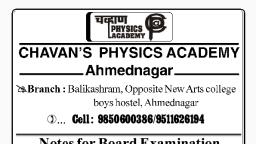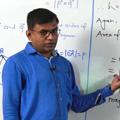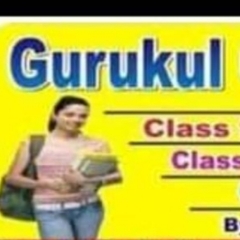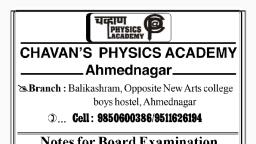Page 1 :
XI-Reg., Batch, , Unit Test | Physics |, , Ray Optics, , 1) Light is a :, a) Transverse waves, b) Longitudinal waves, c) Electromagnetic wave, d) Magic thing, 2) An isotropic medium is that in which, a) speed of light changes, b) speed of light remains constant, c) both (A) and (B), d) direction of propagation of light changes, 3) As per modern theory, light has :, a) particle nature, b) wave nature, c) neither wave nor particle in nature, d) wave as well as particle nature, 4) Relative refractive index ...., a) Always greater than one, b) Always less than one, c) May be greater or less than one, d) Always zero, 5) Focal length of convex mirror is always, a) Positive, b) Negative, c) Zero, d) May be positive of negative, 6) The relation between focal length f and radius, of curvature R is :, a) f = 0.5 R, b) R = 0.5 f, 2, 2, c) f = 2R, d) f = 2R2, 7) A ray optics is valid when characteristic, , dimensions are :, a) Of the same order as wavelength of light, b) Of the order of 10 mm., c) Smaller than wavelength of light, d) Much larger than the wavelength of light, 8) A convex lens of glass becomes less, , convergent in, a) Oil, b) Water, c) Both in oil and water, d) Neither in oil nor in water, , Unit Test, , | Marks : 100 |Time : 45 min.| MHTCET : 2021, 9) A convex driving mirror of focal length 40 cm, is fixed to a car. A second car is 12m away, from the first car. The position of second car in, the mirror is nearly :, a) 50 m, b) 40 m c) 30 m, d) 20 m, 10) Chromatic aberration in the lens is due to :, a) Interference, b) Dispersion, c) Diffraction, d) Polarization, 11) The equiconvex lens has focal length f. If it is, cut perpendicular to the principal axis passing, through optical centre, then focal length of, each half is, a), , f, 2, , b), , c), , 3f, 2, , d) 2, , 12) Colour of light is determined by :, a) Amplitude, b) Wavelength, c) Frequency, d) Phase, 13) The main cause of decrease in intensity of light, on refraction is :, a) Total internal reflection, b) Partial reflection and partial absorption, c) Scattering of light, d) Dispersion of light, 14) A ray of light is incident at an angle of, incidence 35°, the angle between reflecting, surface and reflected ray is :, a) 35° b) 90°, c) 55° d) 75°, 15) A ray is incident at an angle with the surface is, 38°. The angle between normal and reflected, ray is :, a) 38° b) 52°, c) 90°, d)76°, 16) For a certain light, there are 4 × 103 waves in 2, mm in air. The wavelength of light is :, a) 0.5 μm, b) 5 μm, c) 500 μm, d) 5000 μm, 17) The number of images observable between two, parallel plane mirrors are :, a) 2, , b) 4, , c) 8, , d) Infinite, Page 1
Page 2 :
18) The value of refractive index is the highest for:, a) Diamond, b) Oil, c) Water, d) Glass, 19) A plane glass slab is placed on the letters of, different colours, the letter of which colour is, raised by maximum amount:, a) Blue b) Green c) Yellow d) Violet, 20) A bird in air looks at a fish vertically below it, and inside water, x is the height of the bird, above the surface of water and y is depth of the, fish below the surface of water. If refractive, index of water is μ, the distance of the fish as, observed by the bird, a) x, , µ, , b) x+y, , c) μx + y, , d) μx + μy, , 21) Light of wavelength λ in air enters a medium, of refractive index μ. Two points in this, medium lying along a path of light are at a, distance x apart. The phase difference between, these points :, b), , a), , c), , d), , 22) An electromagnetic radiation of frequency v, and wavelength λ travelling with velocity v in, air enters a glass slab of refractive index μ,, then the frequency, wavelength and velocity of, light in the glass slab will be respectively., a), , , ,, µ µ µ, , b), , c), , , ,, d), µ µ µ, , µ µ, , 23) A ray of light passes through four transparent, media with refractive indices, and, as shown in fig. The surfaces of all media are, parallel. If the emergent ray CD is parallel to, incident ray AB. we must have :, , 24) The wavelength of a monochromatic ray of, light is 4560 A° in air and 3648 A° in a, medium. The ratio of the velocity of light in air, and medium will be:, a), 25), , b), , c), , d), , A ray of light passes from glass having a, refractive index 1.6 to air. The angle of, incidence for which the angle of refraction is, twice the angle of incidence is :, a) sin, , b) sin, , c) sin, , d) sin, , 26) To travel through the same distance in two, different media, a light ray of certain frequency, takes different times which are in the ratio 3:5,, the relative refractive index will be :, a), , b), , d) 1: 2, , c), , 27) A vessel of depth 2d cm is half filled with a, liquid of RIμ1 and the upper half is occupied, by a liquid of RIμ1. The apparent depth of the, vessel, viewed perpendicularly is :, a) d, , b) 2d, , c) 2dµ1µ2, , d), , 2d, µ1µ2, , 28) In under water swimmer is at a depth of 1cm, below the surface of water. A bird is at a height, of 18m from the surface of water, directly, above his eyes. For the swimmer, the bird, appears to be at a distance x from the surface, of water : (μw = 4/3) . The value of x is, a) 9 m b) 14 m, c) 20 m, d) 24 m, 29) A ray of light travels from an optically denser, to rarer medium. The critical angle for the two, media is C. The maximum possible angle of, deviation of the ray will be :, a) π + C b) π – C, , c), , –2C, , d) π – 2C, , 30) A fish looking up through the water sees the, outside world contained in a circular horizon., If the R.I. of water is, a), Unit Test, , b), , c), , d), , and fish is 12 cm below, , the surface, the radius of the circle is :, Page 2
Page 3 :
a), , √, , c), , cm, , √, , b) 6√5 cm, , 36) A thin convex lens made from crown glass, , has focal length, cm, , d), , √, , cm, , 31) In vacuum, to travel 'd', light takes time 't' and, in medium to travel distance '5d', it takes time, T'. The critical angle of the medium is, a) sin, , b) sin, , c) sin, , d) sin, , 32) The figure shows a mixture of blue, green, , and red colour ray incident on the right, angled prism. The critical angles of the, material of prism for red, green and blue, colours are 46°, 44° and 43° respectively., The arrangement will separate :, , a) Green colour from red and blue, b) Red colour from green and blue, c) Blue colour from green and red., d) All the three colours., 33) For a prism, the incident and emergent rays are, parallel as shown in figure. The minimum, value of refractive index of the prism material, is :, , . When it is, , measured in two different liquids having, refractive indices, , and, , it has the focal, , lengths f1 and f2 respectively. The correct, relation between the focal lengths is :, a) f2 > f and f1 becomes negative, b) f1 and f2 both becomes negative, c) f1 = f2 < f, d) f1 > f and f2 becomes negative, 37) If concave and convex lens of focal lengths, 50cm and 40 cm respectively are combined, together. The resultant power of the, combination is :, a) –0.5 diopter, b) 90 diopter, c) 10 diopter, d) –10 diopter, 38) A prism of refracting angle 60° deviates the, ray of light through 35°. If the angle of, emergence is 50° then the angle of incidence, will be :, a) 50° b) 45°, c) 40° d) 35°, 39) One face of a prism of refracting angle 30° and, R.I. √2 is silvered. At what angle must a ray of, light falls on the unsilvered face so that after, refraction into the prism and reflection at the, silvered surface it retraces its path?, a) 30° b) 45°, c) 60° d) 75°, 40) The angle of a prism is A. One of its refracting, surfaces is silvered. Light rays falling at an, angle of incidence 2A on the first surface, returns back through the same path after, , a) √2, b) √3, c) 2 d) 3, 34) In an optical fibre during transmission of light :, a) Light partially reflects and refracts, b) No loss of propagation of energy takes place, c) Energy decreases, d) Energy increases, 35) A thin convex lens of R.I. 1.5 has a power +5, diopter. Its focal length becomes 100 cm and a, acts as divergent lens, when immersed in a, liquid of R.I μ. The value of μ is :, a) 1.36 b) 1.66, c) 0.36 d) 0.6636, Unit Test, , suffering reflection at the silvered surface. The, refractive index μ, of the prism is, a) 2 sin A b) 2 cos A, , c), , cosA d) tan A, , 41) Dispersive power depends upon, a) Shape of prism, b) Material of prism, c) Refracting angle of prism, d) Both 'B' and 'C', Page 3
Page 4 :
42) The refractive indices of a prism for violet and, , 49) At the time of viewing a distant object, a small, , red colours are 1.65 and 1.61 respectively, then, , dark spot is made at the centre of objective of, , the dispersive power is, , telescope then :, , a) 6.3, , b) 0.63, , c) 0.0063, , d) 0.063, , 43) The rainbow is an example of :, , a) Dark spot appears enlarged, b) Dark spot will be reduced in size, , a) Total internal reflection of sunlight from, , c) Intensity of an image of object will be, , water drops, , decreased, , b) Reflection of sunlight from water drops, , d) Intensity of an image of object will, , c) Refraction of sunlight from water drops, , increased, , d) Dispersion of sunlight from water drops, 44) M.P. of simple microscope is between, and 1, , b), , c), , and 1, , d) 1D and (1 + D), , v, , v, , u, , telescope is 18 cm. Focal lengths of objective, and eyepiece respectively are :, , a), , and 1, , 50) Magnifying power of telescope is 5. Length of, , u, , a) 15 cm and 3 cm, , b) 3 cm and 15 cm, , c) 3 cm and 21 cm, , d) 21 cm and 3 cm, ****, , 45) M.P of compound microscope is negative,, , which indicates that image is :, a) Virtual and erect, , b) Virtual and inverted, , c) Real and erect, , d) Real and inverted, , 46) Distant object appear much brighter through, telescope because :, a) Size of eyepiece is large, b) Focal length of eyepiece is large, c) Focal length of objective is small, d) Size of objective is very large, 47) An astronomical telescope magnifies an object, five times and its length is 36 cm. The focal, length of objective is :, a) 30 cm, , b) 36 cm, , c) 42 cm, , d) 5 cm, , 48) Maximum magnifying power of telescope, having objective of focal length 50 cm and, eyepiece of focal length 5 cm is :, a) –10, , b) +10, , c) –12, , d) +12, , Unit Test, , Page 4

















































































